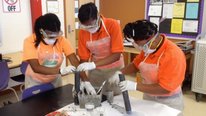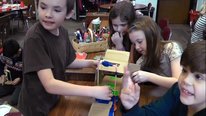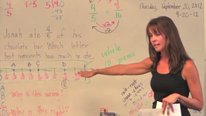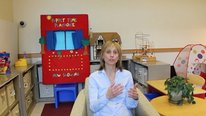- Tamara Moore
- http://web.ics.purdue.edu/~tmoore/
- Associate Professor, Engineering Education & EngrTEAMS Principal Investigator
- EngrTEAMS: Engineering to Transform the Education of Analysis, Measurement, and Science in a Team-Based Targeted Mathematics-Science Partnership
- https://sites.google.com/a/umn.edu/engrteams/
- Purdue University, University of Minnesota
- Cynthia Stevenson
- EngrTEAMS Project Director
- EngrTEAMS: Engineering to Transform the Education of Analysis, Measurement, and Science in a Team-Based Targeted Mathematics-Science Partnership
- https://sites.google.com/a/umn.edu/engrteams/
- Purdue University, University of Minnesota
Public Discussion
Continue the discussion of this presentation on the Multiplex. Go to Multiplex








Julie Steimle
Your project shares a lot of similarities with our project, CEEMS. We have found coaching to be critical to the teachers’ success and we also ask teachers to build STEM units uniquely designed to suit their classrooms. I would be curious to know more about the time commitment for teachers in your project. Also, have you thought about how you will sustain and scale your project once grant funding runs out? We are in the process of trying to find a way to reduce our project to the core elements in order to sustain it beyond grant funding and would be interested in learning others’ ideas.
Tamara Moore
Associate Professor, Engineering Education & EngrTEAMS Principal Investigator
Hi Julie-
The teacher fellows who create the curriculum have a large commitment to the project. They spent 3 weeks with us in PD while they developed their curriculum first draft, then they spent 2.5 days teaching in a pilot with summer camp kids to try out the curriculum. After this, they modified their curriculum based on what they learned in the pilot. During the school year, they had monthly meetings with their coach and two implementation times in the classroom (their curriculum and one other STEM integration unit). The coaches were highly involved with each of these.
We are in the middle of our 4th year of funding. We are now working on sustainability in the school districts and scaling the curricula.
For sustainability, we have started a teacher leadership group that is tailored to each of the school districts’ needs. Here former teacher fellows or other teachers who have been involved in the project take on peer coaching roles. We have a one-week PD with them in the summer and then they have the opportunity to coach teachers in their schools throughout the year (with support from us, of course).
For scalability, we are taking the best of the best curricular units that have been developed and taking them through one more year of design (for a design research study). Field test teachers who are not authors of the curriculum will be putting the curriculum into their classrooms. They will go through a 1-week PD and then implementation. They will help us make final changes to the curricula before we work on publishing.
Thank you for your interest!
Best,
Tamara
Julie Steimle
Thanks, Tamara. Your answer was very helpful. I may come back to you for more information at some point, because your project is so similar to ours.
E Paul Goldenberg
Distinguished Scholar
It’s easy to believe from the description of your work (I looked both at your video and briefly at your engrteams site on mspnet) that this professional development is a great experience for teachers and also has appealing and useful effects for their students.
You also mention the teachers /writing/ curriculum, and this made me think of an NSF project from nearly three decades ago (before the NSF comprehensive curriculum projects), in which a cadre of mathematics teachers (all middle- and high-school, if I’m remembering correctly) were selected statewide for their high quality and creativity, given summer and school-year professional development both in content (mathematics) and curriculum development, with the hopes that at the end, not only would the experience improve /their/ already-good teaching, but that they would write lessons and units based on their ideas that would bring model creative lessons (if not all that personal learning) to other teachers. As advisor to this project, and occasional contributor to the PD, I was totally entranced. But the clearly best product was the cadre of teachers. They learned a lot and it clearly mattered. But what they actually wrote was not so interesting. It looked startlingly like what they had held in their hands /before/ they taught the brilliant lessons that led to them being selected for the project. The lessons they wrote did /not/ expose the creativity that they started with and polished further. Their initial creativity was in how artfully they handled prosaic content in mundane books, and the writing they did at the end resembled “curriculum” as defined by the look of those mundane books.
Whence my question: What did the materials that your group created look like? Because materials have changed so much in three decades, it’s quite imaginable that the products your group produced were better. It’s also clear that the art of teaching and the art of curriculum writing are just not the same, so I’m curious.
Tamara Moore
Associate Professor, Engineering Education & EngrTEAMS Principal Investigator
Hi Paul-
Yes, the curriculum documents have a range of quality as you note. However, through the support from the coaches and the design-based research cycles the curricula go through, many of the units are really great. We are doing a final year of curriculum development with a subset of these curricula (with different field test teachers) so that we can polish them in order to be published.
Best,
Tamara
E Paul Goldenberg
Distinguished Scholar
Wonderful! It seems so /right/ for the development to come centrally from teachers, who are the ones who really understand teaching and kids, but the task itself—designing and crafting materials for use by others—is not the same skill set that makes a wonderful teacher. I’m glad you’re getting both, and would love to see the results.
Deborah Hanuscin
Great project, Tamara! I’m interested in learning more about how you utilize the summer camp experience to pilot test the curriculum and what teachers learn from that— our QuEST project is examining practicum-based professional development experiences!
Tamara Moore
Associate Professor, Engineering Education & EngrTEAMS Principal Investigator
Hi Debi!
Before the pilot the EngrTEAMS Fellows (teacher curriculum designers) have developed a first draft of their unit. During the pilot with summer camp students, the have the opportunity to spend 5 hours on some aspect of the curriculum they want to test with students. Then they take that information and use it to improve their curriculum to the next draft (due shortly after the pilot). Here is a lesson we learned… In the first year, our Fellows used this time to implement parts of the curriculum they were more sure about (we believe they did this because they didn’t want to fail in front of us). So in the subsequent years, we made sure to emphasize the need for using this time as the test for parts they wanted more information about. We also emphasized that we were not judging but rather in this thing with them. By this new emphasis and by helping them feel more comfortable, the pilot has become something very important in the curriculum design process.
Best,
Tamara
Ron Ulseth
Excellent work Tamara. I have worked with so many K-12 teachers who struggle with implementing engineering in their curriculums. Your team and coach based approach so thoroughly empowers teachers to change their classroom experience for students.
Ron
Tamara Moore
Associate Professor, Engineering Education & EngrTEAMS Principal Investigator
Thank you Ron… We believe that both the things we are learning about coaching and the things we are learning about how to help teachers develop curriculum will be useful beyond this project!
Gretal Leibnitz
Hi Tamara and Cynthia!
This team and coach approach is a wonderful professional development opportunity. I value the face-to-face chance the teachers received and am curious about virtual (i.e., on-line) support that was given through the project once the units were developed. Curriculum vision is one step and application is another, so was curious! Also, wondered how your curriculum for teachers supported their awareness of barriers to underrepresented populations, especially in engineering. I think our Engineering Inclusive Teaching (EIT) project might be of interest to you in the same way your project was to us! Thanks for your fabulous work!
Tamara Moore
Associate Professor, Engineering Education & EngrTEAMS Principal Investigator
Hi Gretal-
These are good questions. Most of our coaching support was face-to-face when it could be. However, some of our teams were at different schools or even from different school districts, so they often had electronic meetings (Skype or Google Hangouts, etc.). This facilitated having Fellow teams that were not co-located. There were two types of coaching conversations. One set of conversations were related to supporting the implementation for the curriculum developed through the EngrTEAMS project. These were high engagement and high intensity support structures that generally centered on the actual writing or implementation of the curricular unit. These meetings were directly related to making sure the curricula were implemented in the best way possible for the Fellows. The second was the support for STEM integration in general. Here, these support structures were spread out across the academic year and centered on areas the Fellows identified as things they wanted to work on related to STEM integration. These sustained meetings were more about the Fellows wants and needs for how to change their own practice.
We are always excited to learn more about how to help underrepresented populations engage with engineering. We will make sure to look at your project. At this point, we provided PD on this issue and our frameworks that guide their work include some effective practices we gathered from literature. Many of the Fellows work in highly diverse schools, so there has been an opportunity to test the effectiveness of the curriculum in these settings. We have some research on the motivation and interest of the students involved in our project. In this research, it was consistent that these curricula improved the motivation and interest for all demographics in the study. Our four school partners represent contiguous school districts that go from inner urban and branch out toward suburban. Our goal for the curricula is to understand how it works in all settings. We’ll make sure to look at your project.
Best,
Tamara
Julie Steimle
Tamara, I would like to learn a little more about the teams that met electronically, as opposed to face to face. Were those teams as cohesive and productive as the teams that met face to face? I am curious because we are exploring online coaching as a spin off to our grant project. However, we are concerned that the lack of face to face interaction between coaches and their mentees may negatively impact the ability for the two to bond and work well together.
Tamara Moore
Associate Professor, Engineering Education & EngrTEAMS Principal Investigator
Hi Julie-
I put this question to Gillian Roehrig – our coPI at the University of Minnesota that leads the coaching aspect of this project. She said the following, “In EngrTEAMS, online coaching was very successful but the teams had built rapport with each other and their coach first in a face-to-face setting.” I hope this is helpful.
Best,
Tamara
Julie Steimle
Thank you, Tamara. It makes sense that online coaching would have a greater chance of success if the coach and the team members met face to face initially.
Courtney Arthur
It is great to see teachers taking charge of the materials that they are teaching and really engaging in the design and implementation. I am curious how recruiting happens for this work and whether there were any challenges associated with that (especially finding ‘teams’)?
Tamara Moore
Associate Professor, Engineering Education & EngrTEAMS Principal Investigator
Hi Courtney-
Our fellows are recruited from the school district partners involved in our MSP project. The school leaders who sit on the partnership team for the entire grant each can recruit in their district in any way they see fit. One thing that we focused on was to make sure the teacher fellows were selected because the school leaders recognized them as people who would thrive in this type of atmosphere. We made sure the fellows understood that they were chosen for this work (more than just self-selected). We also make sure the fellows understand that they are our partners in this work (we are not doing something to them, but rather we are creating things together). This has really helped all aspects of the project.
In terms of the teams, they are chosen once the teachers come to the summer institute. They self form teams based on interest in working on the same curricular idea and grade level. Some fellows come knowing they want to work with particular people, while others are happy to form teams once they come. This means we have a nice variety of teams that are school-based teams, district-based teams, and inter-district teams – all of which have been successful overall.
Best,
Tamara
Miriam Gates
Researcher
This is really interesting work. I saw some mention earlier in the discussion of coaches coming through the program (former-teacher participants) and from the video I saw that some were graduate students (and perhaps former teacher-participants). Since it seems the coaching play such an important role in the project, I wonder what kind of additional training was provided for coaches and what form it took.
Tamara Moore
Associate Professor, Engineering Education & EngrTEAMS Principal Investigator
Hi Miriam-
For the first three years of the grant, we were having teachers develop the curriculum for their classrooms. During this time, the coaches were graduate students. The graduate students took a graduate level coaching course each year – so the training is extensive here.
We are now moving into the next phase of the project, which addresses scalability and sustainability. For the scalability, we are taking a subset of the curricula and taking them through another set of the design-research cycle with new teachers who were not the fellows who designed them (we call these teachers “field test teachers”). The graduate students are now moving to support the design-research aspects of the curriculum development – so no longer in a coaching role.
For the sustainability, we are working with the district partners to develop plans to continue the coaching aspects of the grant once the money runs out. We are doing this through a “teacher leadership institute”. We ran a pilot last year So generally the teachers that are participating in this aspect of the grant are former fellows or were somehow already involved in the grant in some other way. These teacher leaders go through a different institute for coaching and then get to practice through one of two ways. Some of the teacher leaders will coach the field test teachers this summer while they implement the curricula, and others will have roles for STEM integration coaching in their school districts as decided by their administration.
Best,
Tamara
Miriam Gates
Researcher
This seems like a really great model for sustainability. I’m curious about coaching in the districts where you are working. It seems like in many of the districts with which we have worked, coaching has been cut due to budget priorities.. Does it seem likely that the districts with which you are working will continue to put a value on coaching? In particular, I’m wondering if you think this project has been influential in their decision to continue to support coaches.
Tamara Moore
Associate Professor, Engineering Education & EngrTEAMS Principal Investigator
This is a great question. Each district has been designing their own version of how the coaching will work. Each district has PLCs. In some, I believe they will be the PLC leaders. But in all cases, I believe they are also still classroom teachers. A few will get some release time, but I don’t think this is the overall plan. We are just starting the teacher leadership (other than the small pilot we did last year) this summer, so stay tuned as we learn more.
Jason Balsbaugh
This is a very interesting model for teachers in the intermediate and middle school grades especially with the aspect of the collaboration with universities. Have you considered similar PD opportunities with teachers of grades K-3? We know that the earlier students can be exposed to meaningful content-based engineering learning experiences, the more likely they will gravitate to STEM-based courses and careers. Another question that I had was what tends to the be the make-up of the public school districts represented by the teachers in the program? It would be interesting to know what types of backgrounds the students have who are benefiting from this program.
Cynthia Stevenson
EngrTEAMS Project Director
Thanks for your comments, Jason. Although our grade-level focus right now is 4-8 with an emphasis on vertical alignment, we agree that an earlier exposure to the excitement of content-based engineering learning experiences would be another great avenue to pursue. Some of our participating elementary teachers also serve as K-5 science specialists for their building so their early grades students do tangentially benefit from their learning and work on the project.
The make-up of our school district partners is an intentional spread from inner urban schools to “first ring” suburbs (a mix of urban/suburban) and suburban, so their students come from a wide variety of backgrounds. The demographics of our three core partners are:
1) St Paul Public Schools – With approximately 39,000 students, SPPS is Minnesota’s second-largest school district. Over 75 percent of students come from communities of color (30% African American, 30% Asian American, 14% Latino, 2% American Indian, and 24% White). More than 70% of SPPS students are eligible for the federal free and reduced-price lunch program. Many of the district’s students come from immigrant/refugee families and 45% live in homes in which English is not the first language spoken.
2) North St. Paul-Maplewood-Oakdale is an urban, inner-ring suburban district with 11,000 students grades K-12, 41% of students of color, 42% students receive free or reduced-price lunch, and 35 different languages are spoken by the students and their families, and
3) South Washington County Schools is a second-ring suburban district with 17,000 students grades K-12, 25% students of color and 19% of students receiving free or reduced-price lunch.
Further posting is closed as the showcase has ended.